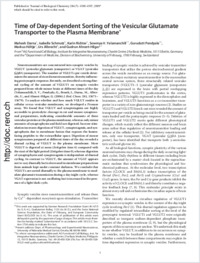Time of day-dependent sorting of the vesicular glutamate transporter to the plasma membrane
- Darna, Mahesh AG Functional Cell Biology, Institute for Integrative Neuroanatomy, Charité Centre 2 for Basic Medicine, Berlin, Germany
- Schmutz, Isabelle Department of Medicine, Division of Biochemistry, University of Fribourg, Switzerland
- Richter, Karin AG Functional Cell Biology, Institute for Integrative Neuroanatomy, Charité Centre 2 for Basic Medicine, Berlin, Germany
- Yelamanchili, Sowmya V. AG Functional Cell Biology, Institute for Integrative Neuroanatomy, Charité Centre 2 for Basic Medicine, Berlin, Germany - Dept. of Pharmacology and Experimental Neuroscience, University of Nebraska Medical Center, Omaha, USA
- Pendyala, Gurudutt Department of Medicine, Division of Biochemistry, University of Fribourg, Switzerland - Dept. of Pharmacology and Experimental Neuroscience, University of Nebraska Medical Center, Omaha, USA
- Höltje, Markus AG Functional Cell Biology, Institute for Integrative Neuroanatomy, Charité Centre 2 for Basic Medicine, Berlin, Germany
- Albrecht, Urs Department of Medicine, Division of Biochemistry, University of Fribourg, Switzerland
- Ahnert-Hilger, Gudrun AG Functional Cell Biology, Institute for Integrative Neuroanatomy, Charité Centre 2 for Basic Medicine, Berlin, Germany
-
22.12.2008
Published in:
- Journal of Biological Chemistry. - 2009, vol. 284, no. 7, p. 4300-4307
French
Neurotransmitters are concentrated into synaptic vesicles by VGLUT (vesicular glutamate transporter) or VGAT (vesicular GABA transporter). The number of VGLUTs per vesicle determines the amount of stored neurotransmitter, thereby influencing postsynaptic response. Recently, we described a strong diurnal cycling of the amount of VGLUT1 on synaptic vesicles prepared from whole mouse brain at different times of the day (Yelamanchili, S. V., Pendyala, G., Brunk, I., Darna, M., Albrecht, U., and Ahnert-Hilger, G. (2006) J. Biol. Chem. 281, 15671–15679). To analyze whether and how much VGLUT resides in cellular versus vesicular membranes, we developed a Pronase assay. We found that VGLUT and synaptotagmin are highly accessible to proteolytic cleavage in rat and mouse synaptosomal preparations, indicating considerable amounts of these vesicular proteins at the plasma membrane, whereas only minor amounts of synaptophysin and Rab3 are digested. Sucrose stimulation increases digestion of VGLUT, synaptotagmin, and synaptophysin due to membrane fusion that exposes the lumen-facing peptides to the extracellular space. Digestion of mouse synaptosomes prepared at different times of the day revealed a diurnal cycling of VGLUT to the plasma membrane. More VGLUT is digested at noon (Zeitgeber time 6) compared with the start of the light period (Zeitgeber time 0), whereas digestion of synaptophysin and synaptotagmin is independent of diurnal cycling. In contrast to VGLUT, the amount of VGAT appears not to vary diurnally but is decreased in membrane preparations from animals kept under constant darkness. We conclude that VGLUTs are sorted diurnally to the plasma membrane to modulate glutamate transmission during a day/night cycle, whereas VGAT expression is not oscillating but is increased in the presence of a light/dark cycle.
- Faculty
- Faculté des sciences et de médecine
- Department
- Département de Biologie
- Language
-
- English
- Classification
- Biological sciences
- License
- License undefined
- Identifiers
-
- RERO DOC 11720
- DOI 10.1074/jbc.M805480200
- Persistent URL
- https://folia.unifr.ch/unifr/documents/301106
Statistics
Document views: 57
File downloads:
- albrecht_tdd.pdf: 98
